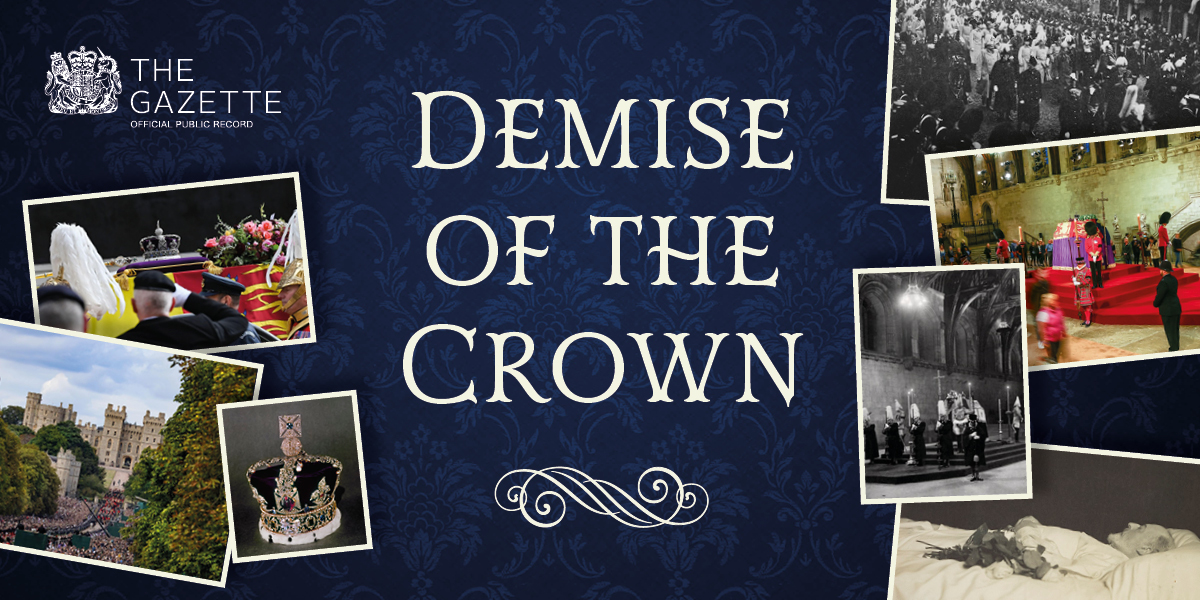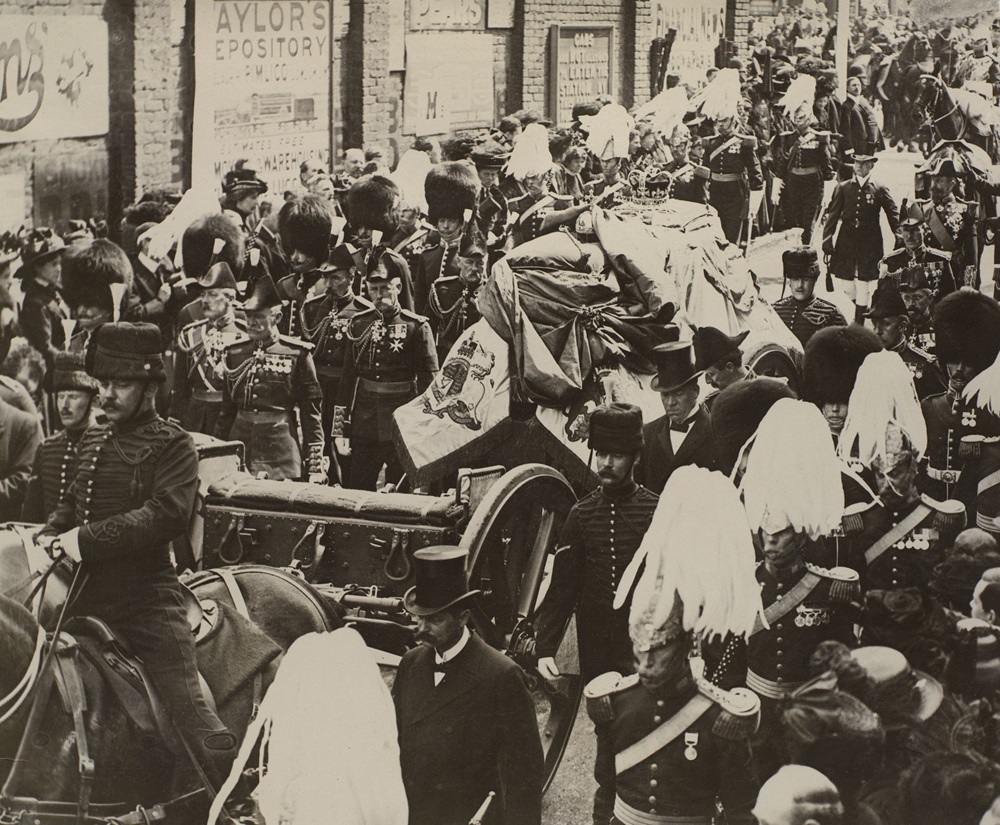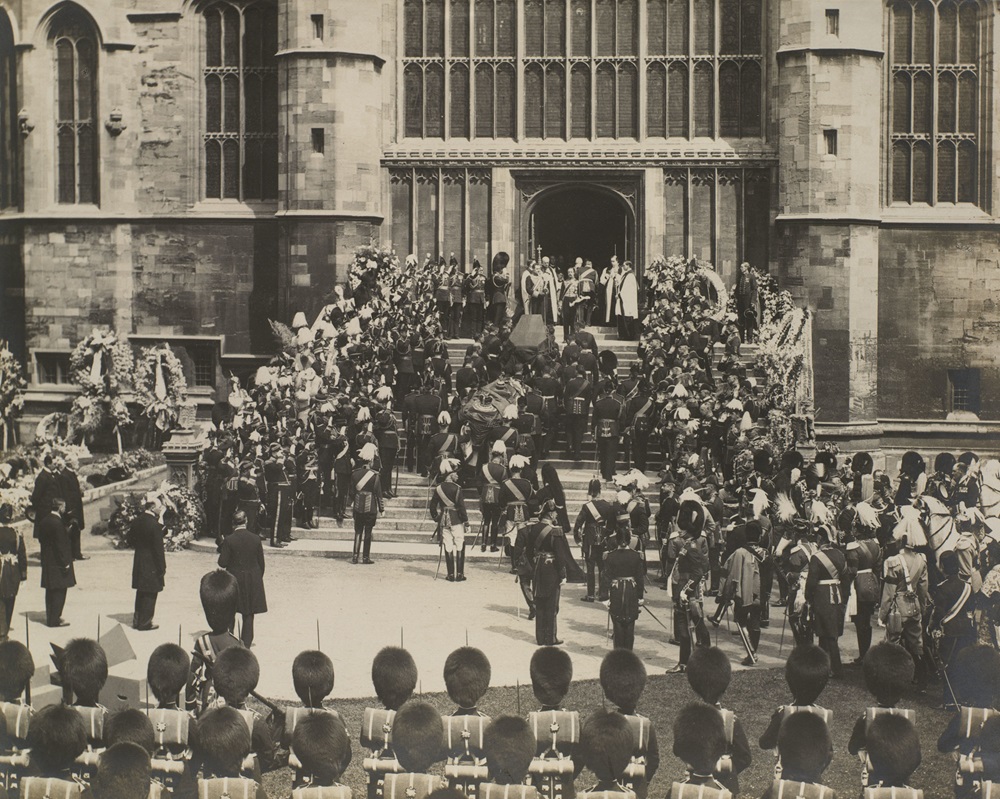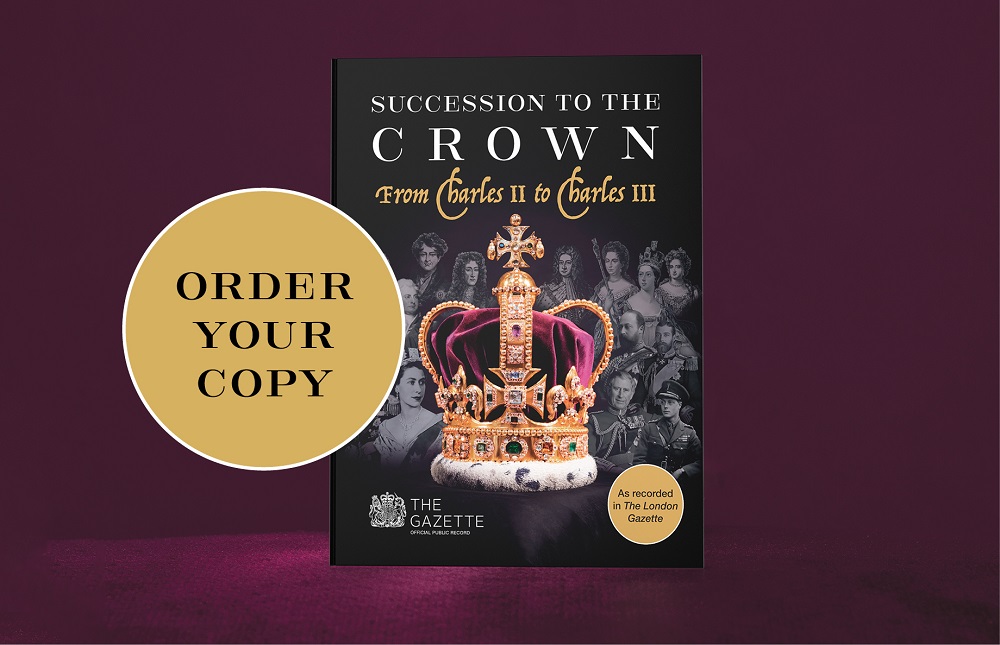Demise of the Crown: #19: Westminster Hall

As the official public record since 1665, The Gazette has been recording the deaths of monarchs for over three centuries. As part of our ‘Demise of the Crown’ series, historian Russell Malloch looks through the archives at The Gazette’s reporting of demise events following the death of King Edward VII.
Between the demise of the crown in 1901 and the close of the 20th century The Gazette reported death and mourning notices, and the funeral ceremonial, for three sovereigns.
The policy of gazetting notices and ceremonials for the royal family was revised after Victoria expired, and while The Gazette reported the passing of two queens consort, Alexandra in 1925 (Gazette issue 33106) and Mary in 1953 (Gazette issue 39808), it did not contain any account of their funerals. That information was later published in the Court Circular, and/or through the usual media, as was the case following the departure of other family members
The programmes to mark the passing of Edward VII in 1910, George V in 1936 and George VI in 1952 were organised along similar lines to those of Queen Victoria, but contrasted with the 1901 precedent, as the main service was preceded by a lying in state in London, which was followed by the usual funeral service in St George’s Chapel, and by burial in more modest surroundings than the Victoria and Albert mausoleum at Frogmore.
The challenge of conveying the sovereign’s remains to Windsor had to be addressed in 1901, because Victoria breathed her last on the Isle of Wight. A similar, although less complicated journey, was organised when the demise of the crown took place at Sandringham in Norfolk in 1936 and 1952, and an even more complex plan had to be implemented after Elizabeth II died in Scotland in 2022.

King Edward VII
Edward VII’s death on 6 May 1910 presented a more straightforward situation, as he expired at Buckingham Palace, as confirmed in the bulletin the royal doctors sent to the home secretary, Winston Churchill (Gazette issue 28364). Matters might have been quite different, as a few days earlier the King was on holiday at Biarritz in France with his companion Alice Keppel, the great-grandmother of Queen Camilla. He arrived home on 27 April, and spent his last weekend at Sandringham, in the company of Frederick Ponsonby, who played such an important role at Victoria’s funeral.
The King reached London only four days before his death, and on returning from Sandringham, one of his last official acts was to receive Edmund Poe, who earned the first MVO for repatriating the remains of Prince Henry of Battenburg and had recently been appointed the naval commander-in-chief in the Mediterranean.
Edward was unwell on the following day, and unable to meet Queen Alexandra on her return from Corfu, and he expired the next day. The Court Circular explained that during the last moments, the archbishop of Canterbury “read special prayers and conducted a short service in the King’s room”, at which Queen Alexandra, the Prince of Wales and a few other family members were present.
This was the first occasion on which the provisions of the Demise of the Crown Act of 1901 were engaged (Gazette issue 27330), and so no offices that were held under the crown were affected, and no fresh appointments were rendered necessary by the demise. On the other hand, King George was free to change the composition of his household, as he was now the sovereign of the British Empire, rather than merely the heir to the crown. The Gazette of June 1910 dealt with the main court jobs, with Frederick Ponsonby being appointed as one of the two assistant private secretaries to the King (Gazette issue 28383).
In terms of continuity following a demise of the crown, and despite the provisions of the 1901 act, the King signed a warrant that followed the measures from March 1901, and provided that the current royal commissions, ranging from historical manuscripts and the Welsh church to vivisection, should “continue their labours” (Gazette issue 28379). Similar warrants were gazetted in February and December 1936, to deal with the status of the commissions that were operating when George V died (Gazette issue 34255), and Edward VIII abdicated (Gazette issue 34352).
Lying in state
The King’s remains lay in state at Buckingham Palace until 17 May 1910, when the sequence of the ceremonial began to be described in The Gazette (Gazette issue 28401). The coffin was placed on a gun carriage drawn by horses, with a royal standard, regalia and Garter insignia, accompanied by the King’s Company of the Grenadier Guards. The pall bearers were once again equerries rather than dukes, and included a second ‘demise of the crown’ outing for Frederick Ponsonby and Arthur Davidson.
The Edwardian pageantry combined the armed forces emphasis from 1901, with a public lying in state in Westminster Hall, where the King was a pall bearer at the public funeral for prime minister William Gladstone in 1898.
The great hall in the heart of London dated from the 14th century, and had been used for a range of royal and state business. It was the scene of the trial of Charles I in 1649, and for many years it housed the principal English law court, although its judicial role fell away after the Royal Courts of Justice was opened, an event The Gazette noticed in 1882 (Gazette issue 25177).
The hall also provided the setting for the banquets that followed the coronation services, a practice that was last observed in 1821 after the crowning of George IV. The banquet was an extravagant and costly business, and while it may have fallen out of favour, it was not forgotten. The Gazette of 1901 (Gazette issue 27327) published a proclamation about the procedures for Edward VII’s coronation, which dispensed with “the services and attendance of all persons who do claim and are bound to do and perform any services which, according to ancient custom or usage, are to be performed in Westminster Hall or in the procession.” Similar dispensations were gazetted in connection with the coronations of 1911, 1937 and 1953.

Funeral protocol
King George V was joined in the funeral procession by his sons Edward and Albert – the future Kings Edward VIII and George VI – and by the Danish and Norwegian monarchs who were already in England. The coffin was placed on a catafalque in Westminster Hall, where a service was performed in accordance with a text that was reproduced in The Gazette. During the lying in state, the Gentlemen at Arms and Yeomen of the Guard were joined by the King’s Gurkha orderly officers.
The Gazette contained the earl marshal’s notice explaining that the King’s remains would lie in state in Westminster Hall from 17 to 20 May, and that the public would be admitted on three days.
The journey from Westminster Hall to Windsor began on 20 May, with the main London march conveying the coffin from its lying in state to Paddington Station. The King was joined in the second procession by eight foreign monarchs, as the Danish and Norwegian sovereigns now walked beside the German Emperor and the monarchs of Belgium, Bulgaria, Greece, Portugal and Spain.
The presence of the crowned heads is notable, given that Edward had followed his mother’s example, and never attended the funeral of any European neighbour, even although some were close relations, and he had visited their realms during his short time on the throne. Like his mother, Edward was usually represented at foreign obsequies by a senior family member. His brother Arthur, Duke of Connaught, attended the funerals of the Grand Duke of Baden at Karlsruhe in 1907 (Gazette issue 28069), and Leopold of the Belgians at Brussels in 1909, while his nephew, Prince Arthur of Connaught, performed a similar role at the services for Oscar of Sweden at Stockholm in 1907 (Gazette issue 28093), and for Charles of Portugal at Lisbon in 1908.
The presence of the foreign kings in 1910 did not alter the policy of the sovereign and his advisers, or the London government, and the British head of state continued not to attend the funeral of foreign monarchs. On the other hand, Edward and his successors were often present at memorial services in London, as Edward did in 1907 and 1908 for the kings of Sweden and Portugal.
One change to the naval and military aspect of the parade was reflected in The Gazette, as the procession included units from the police and fire brigades, although this was counterbalanced by places being given to officers of the most senior rank in the navy and army, those of admiral of the fleet and field marshal.
London to Windsor
On its arrival at Windsor, Edward’s casket was delivered into the care of a naval detachment, no doubt as a way of recognising the success of the 1901 operation, when the Royal Navy stepped in to replace the army’s restive horses.
Once again, the plan for this phase of the obsequies contained a few subtle changes, as the English officers of arms were joined by their heraldic colleagues from Ireland and Scotland. One well-known foreign representative was Theodore Roosevelt, the former president of the United States of America, while Pierre Forsans, the mayor of Biarritz (Gazette issues 28243), which was the late King’s favoured holiday destination, also walked in the procession with the French delegation. The printed ceremonial did not disclose the fact that the King’s dog Caesar appeared in the parade, in the care of a Highland attendant.
The prayers were read and the benediction given by Randall Davidson, the archbishop of Canterbury and former dean of Windsor, who would crown Edward’s successor in Westminster Abbey in 1911. The late sovereign’s titles were proclaimed at the end of the service by Garter king of arms, and continued to be limited to his sovereignty of the Order of the Garter, while The Gazette recorded an additional step in the procedure, as the Duke of Connaught handed his nephew the company colour of the King’s Company of the Grenadier Guards, which George V then placed on his father’s coffin.
The master of the household, Sir Charles Frederick (Gazette issue 28046), was given the privilege of casting earth upon the King’s casket and, as in 1901, there was no report in The Gazette of any wands of office being broken by the lord chamberlain, or any of the other senior officers of the household who were present.

Edward’s tomb
The burial of Edward VII’s remains was less straightforward than it had been for those of his mother in 1901, as she was always destined to lie beside the Prince Consort in their sarcophagus that was ready and waiting at Frogmore. No such provision existed for Edward, or for George V or George VI (or for the former King Edward VIII), and in contrast to the situation in 2022, when Queen Elizabeth II had a known resting place in her father’s memorial chapel at Windsor.
Edward’s casket was initially housed in the royal vault at Windsor, while steps were taken to erect a tomb in the nearby nave, to house the remains of the King and his consort. The tomb showed Edward in his Garter robes and with his dog Caesar at his feet and was ready to be occupied by the early 1920s.
This was a period during which the chapel was closed for several years, to allow for an extensive programme of repairs to be carried out, and by the time St George’s was ready to be reopened to the public Alexandra had died, and so the remains of husband and wife were united in the tomb in 1927. The Garter banners of the King and Queen were later hung over their effigies near the altar.

Succession to the Crown: From Charles II to Charles III
Succession to the Crown is essential reading for anyone with a keen interest in the British royal family and provides an excellent and trusted source of information for historians, researchers and academics alike. The book takes you on a journey exploring the coronations, honours and emblems of the British monarchy, from the demise of King Charles II in 1685, through to the accession of King Charles III, as recorded in The London Gazette.
Historian Russell Malloch tells the story of the Crown through trusted, factual information found in the UK's official public record. Learn about the traditions and ceremony engrained in successions right up to the demise of Queen Elizabeth II and the resulting proclamation and accession of King Charles III.
Available to order now from the TSO Shop.
About the author
Russell Malloch is a member of the Orders and Medals Research Society and an authority on British honours. He authored Succession to the Crown: From Charles II to Charles III, which explores the coronations, honours and emblems of the British monarchy.
See also
King Charles III and The Gazette
Gazette Firsts: The history of The Gazette and monarch funerals
Find out more
Succession to the Crown: - From Charles II to Charles III (TSO shop)
Images
The Gazette
Royal Collection Trust / © His Majesty King Charles III 2025
Royal Collection Trust / © His Majesty King Charles III 2025
Royal Collection Trust / © His Majesty King Charles III 2025
The Gazette
Publication date
24 February 2025
Any opinion expressed in this article is that of the author and the author alone, and does not necessarily represent that of The Gazette.
